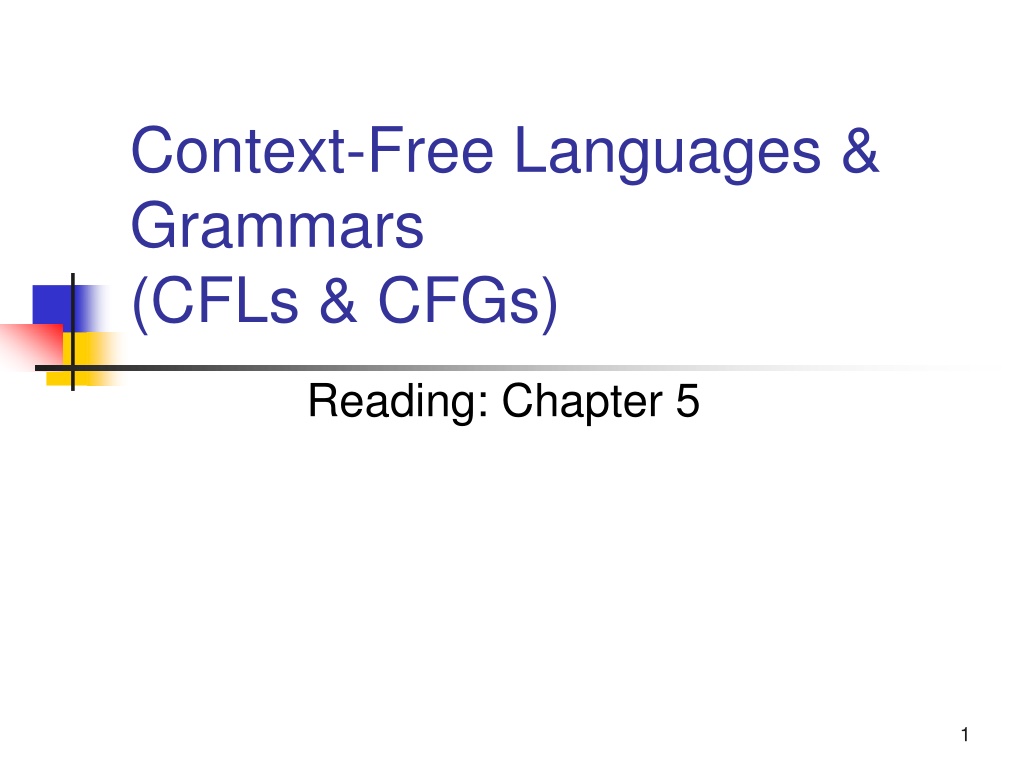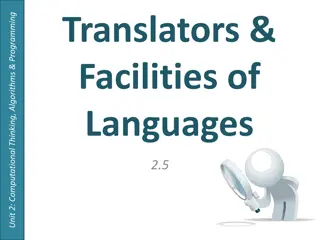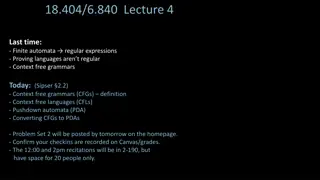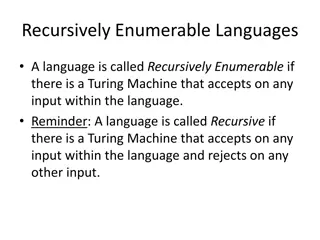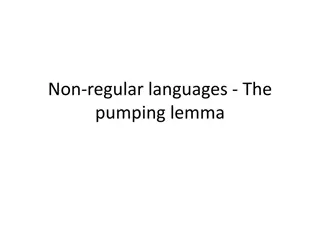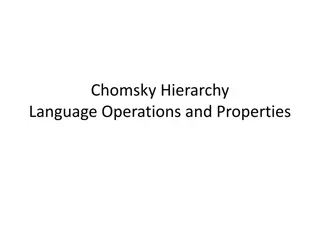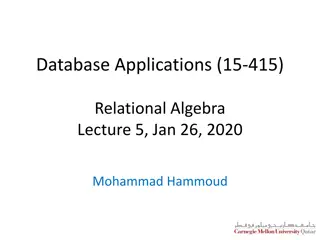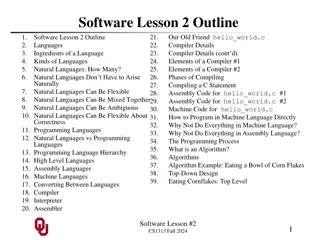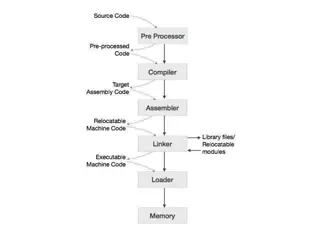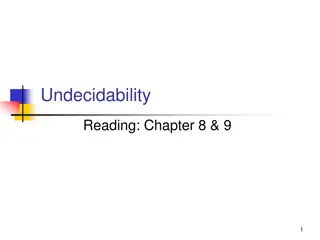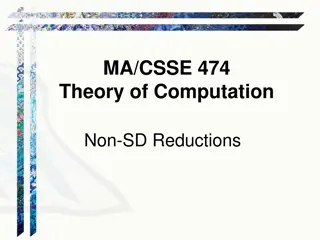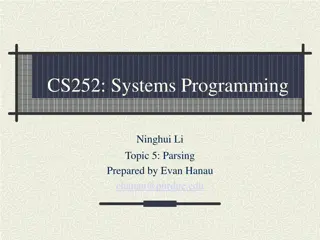Understanding Context-Free Languages and Grammars
Context-Free Languages and Grammars (CFLs & CFGs) are essential in theoretical computer science, providing a framework for recognizing non-regular languages. This content explores the distinction between regular and context-free languages, delves into the construction of language recognizers using context-free grammars, and offers insights into the language of palindromes as an example of a CFL with recursive properties. The discussion includes the concept of context-free grammars, their definition, application in recognizing binary palindromes, and the working mechanism of CFGs in generating strings that belong to a language.
Download Presentation

Please find below an Image/Link to download the presentation.
The content on the website is provided AS IS for your information and personal use only. It may not be sold, licensed, or shared on other websites without obtaining consent from the author. Download presentation by click this link. If you encounter any issues during the download, it is possible that the publisher has removed the file from their server.
E N D
Presentation Transcript
Context-Free Languages & Grammars (CFLs & CFGs) Reading: Chapter 5 1
Not all languages are regular So what happens to the languages which are not regular? Can we still come up with a language recognizer? i.e., something that will accept (or reject) strings that belong (or do not belong) to the language? 2
Context-Free Languages A language class larger than the class of regular languages Supports natural, recursive notation called context- free grammar Applications: Parse trees, compilers XML Context- free Regular (FA/RE) (PDA/CFG) 3
An Example A palindrome is a word that reads identical from both ends E.g., madam, redivider, malayalam, 010010010 Let L = { w | w is a binary palindrome} Is L regular? No. Proof: Let w=0N10N By Pumping lemma, w can be rewritten as xyz, such that xykz is also L (for any k 0) But |xy| N and y ==> y=0+ ==> xykz will NOT be in L for k=0 ==> Contradiction (assuming N to be the p/l constant) 4
But the language of palindromes is a CFL, because it supports recursive substitution (in the form of a CFG) This is because we can construct a grammar like this: A ==> A ==> 0 A ==> 1 A ==> 0A0 A ==> 1A1 Same as: A => 0A0 | 1A1 | 0 | 1 | 1. Terminal 2. 3. Variable or non-terminal Productions 4. 5. How does this grammar work? 5
How does the CFG for palindromes work? An input string belongs to the language (i.e., accepted) iff it can be generated by the CFG G: A => 0A0 | 1A1 | 0 | 1 | Example: w=01110 G can generate w as follows: Generating a string from a grammar: 1. Pick and choose a sequence of productions that would allow us to generate the string. 2. At every step, substitute one variable with one of its productions. A => 0A0 => 01A10 => 01110 1. 2. 3. 6
Context-Free Grammar: Definition A context-free grammar G=(V,T,P,S), where: V: set of variables or non-terminals T: set of terminals (= alphabet U { }) P: set of productions, each of which is of the form V ==> 1 | 2| Where each i is an arbitrary string of variables and terminals S ==> start variable CFG for the language of binary palindromes: G=({A},{0,1},P,A) P: A ==> 0 A 0 | 1 A 1 | 0 | 1 | 7
More examples Parenthesis matching in code Syntax checking In scenarios where there is a general need for: Matching a symbol with another symbol, or Matching a count of one symbol with that of another symbol, or Recursively substituting one symbol with a string of other symbols 8
Example #2 Language of balanced paranthesis e.g., ()(((())))((())) . CFG? G: S => (S) | SS | How would you interpret the string (((()))()()) using this grammar? 9
Example #3 A grammar for L = {0m1n| m n} CFG? G: S => 0S1 | A A => 0A | How would you interpret the string 00000111 using this grammar? 10
Example #4 A program containing if-then(-else) statements if Conditionthen StatementelseStatement (Or) ifConditionthenStatement CFG? 11
More examples L1 = {0n| n 0 } L2 = {0n| n 1 } L3={0i1j2k| i=j or j=k, where i,j,k 0} L4={0i1j2k| i=j or i=k, where i,j,k 1} 12
Applications of CFLs & CFGs Compilers use parsers for syntactic checking Parsers can be expressed as CFGs Balancing paranthesis: B ==> BB | (B) | Statement Statement ==> If-then-else: S ==> SS | if Condition then Statement else Statement | if Condition then Statement | Statement Condition ==> Statement ==> C paranthesis matching { } Pascal begin-end matching YACC (Yet Another Compiler-Compiler) 1. 2. 3. 4. 5. 13
More applications Markup languages Nested Tag Matching HTML <html> <p> <a href= > </a> </p> </html> XML <PC> <MODEL> </MODEL> .. <RAM> </RAM> </PC> 14
Tag-Markup Languages Roll ==> <ROLL> Class Students </ROLL> Class ==> <CLASS> Text </CLASS> Text ==> Char Text | Char Char ==> a | b | | z | A | B | .. | Z Students ==> Student Students | Student ==> <STUD> Text </STUD> Here, the left hand side of each production denotes one non-terminals (e.g., Roll , Class , etc.) Those symbols on the right hand side for which no productions (i.e., substitutions) are defined are terminals (e.g., a , b , | , < , > , ROLL , etc.) 15
Structure of a production derivation body head A =======> 1 | 2| | k The above is same as: A ==> 1 A ==> 2 A ==> 3 1. 2. 3. K. A ==> k 16
CFG conventions Terminal symbols <== a, b, c Non-terminal symbols <== A,B,C, Terminal or non-terminal symbols <== X,Y,Z Terminal strings <== w, x, y, z Arbitrary strings of terminals and non- terminals <== , , , .. 17
Syntactic Expressions in Programming Languages result = a*b + score + 10 * distance + c Operators are also terminals variables terminals Regular languages have only terminals Reg expression = [a-z][a-z0-1]* If we allow only letters a & b, and 0 & 1 for constants (for simplification) Regular expression = (a+b)(a+b+0+1)* 18
String membership How to say if a string belong to the language defined by a CFG? Derivation Head to body Recursive inference Body to head Example: w = 01110 Is w a palindrome? 1. Both are equivalent forms 2. G: A => 0A0 | 1A1 | 0 | 1 | A => 0A0 => 01A10 => 01110 19
Simple Expressions We can write a CFG for accepting simple expressions G = (V,T,P,S) V = {E,F} T = {0,1,a,b,+,*,(,)} S = {E} P: E ==> E+E | E*E | (E) | F F ==> aF | bF | 0F | 1F | a | b | 0 | 1 20
Generalization of derivation Derivation is head ==> body A==>X A ==>*G X (A derives X in a single step) (A derives X in a multiple steps) Transitivity: IFA ==>*GB, and B ==>*GC, THEN A ==>*G C 21
Context-Free Language The language of a CFG, G=(V,T,P,S), denoted by L(G), is the set of terminal strings that have a derivation from the start variable S. L(G) = { w in T* | S ==>*G w } 22
Left-most & Right-most Derivation Styles G: E => E+E | E*E | (E) | F F => aF | bF | 0F | 1F | E =*=>G a*(ab+10) Derive the string a*(ab+10) from G: E ==> E * E ==> F * E ==> aF * E ==> a * E ==> a * (E) ==> a * (E + E) ==> a * (F + E) ==> a * (aF + E) ==> a * (abF + E) ==> a * (ab + E) ==> a * (ab + F) ==> a * (ab + 1F) ==> a * (ab + 10F) ==> a * (ab + 10) E ==> E * E ==> E * (E) ==> E * (E + E) ==> E * (E + F) ==> E * (E + 1F) ==> E * (E + 10F) ==> E * (E + 10) ==> E * (F + 10) ==> E * (aF + 10) ==> E * (abF + 0) ==> E * (ab + 10) ==> F * (ab + 10) ==> aF * (ab + 10) ==> a * (ab + 10) Left-most derivation: Right-most derivation: Always substitute leftmost variable Always substitute rightmost variable 23
Leftmost vs. Rightmost derivations Q1) For every leftmost derivation, there is a rightmost derivation, and vice versa. True or False? True - will use parse trees to prove this Q2) Does every word generated by a CFG have a leftmost and a rightmost derivation? Yes easy to prove (reverse direction) Q3) Could there be words which have more than one leftmost (or rightmost) derivation? Yes depending on the grammar 24
How to prove that your CFGs are correct? (using induction) 25
Gpal: A => 0A0 | 1A1 | 0 | 1 | CFG & CFL Theorem: A string w in (0+1)* is in L(Gpal), if and only if, w is a palindrome. Proof: Use induction on string length for the IF part On length of derivation for the ONLY IF part 26
Parse trees 27
Parse Trees Each CFG can be represented using a parse tree: Each internal node is labeled by a variable in V Each leaf is terminal symbol For a production, A==>X1X2 Xk, then any internal node labeled A has k children which are labeled from X1,X2, Xk from left to right Parse tree for production and all other subsequent productions: A ==> X1..Xi..Xk A X1 Xi Xk 28
Examples E Recursive inference A E + E 0 0 A F F Derivation 1 A 1 a 1 Parse tree for 0110 Parse tree for a + 1 G: E => E+E | E*E | (E) | F F => aF | bF | 0F | 1F | 0 | 1 | a | b G: A => 0A0 | 1A1 | 0 | 1 | 29
Parse Trees, Derivations, and Recursive Inferences Production: A ==> X1..Xi..Xk A Derivation Recursive X1 Xi Xk inference Parse tree Left-most derivation Derivation Right-most derivation Recursive inference 30
Interchangeability of different CFG representations Parse tree ==> left-most derivation DFS left to right Parse tree ==> right-most derivation DFS right to left ==> left-most derivation == right-most derivation Derivation ==> Recursive inference Reverse the order of productions Recursive inference ==> Parse trees bottom-up traversal of parse tree 31
Connection between CFLs and RLs 32
What kind of grammars result for regular languages? CFLs & Regular Languages A CFG is said to be right-linear if all the productions are one of the following two forms: A ==> wB (or) A ==> w Where: A & B are variables, w is a string of terminals Theorem 1: Every right-linear CFG generates a regular language Theorem 2: Every regular language has a right-linear grammar Theorem 3: Left-linear CFGs also represent RLs 33
Some Examples 0 1 0,1 0 1 A => 01B | C B => 11B | 0C | 1A C => 1A | 0 | 1 1 0 1 0 1 A B C A B 0 C Right linear CFG? Finite Automaton? Right linear CFG? 34
Ambiguity in CFGs A CFG is said to be ambiguous if there exists a string which has more than one left-most derivation Example: S ==> AS | A ==> A1 | 0A1 | 01 LM derivation #1: S => AS => 0A1S =>0A11S => 00111S => 00111 LM derivation #2: S => AS => A1S => 0A11S => 00111S => 00111 Input string: 00111 Can be derived in two ways 36
Why does ambiguity matter? Values are different !!! E ==> E + E | E * E | (E) | a | b | c | 0 | 1 string = a * b + c E LM derivation #1: E => E + E => E * E + E ==>* a * b + c E + E (a*b)+c c E * E a b E LM derivation #2 E => E * E => a * E => a * E + E ==>* a * b + c E E a*(b+c) * a E + E The calculated value depends on which of the two parse trees is actually used. b c 37
Removing Ambiguity in Expression Evaluations It MAY be possible to remove ambiguity for some CFLs E.g.,, in a CFG for expression evaluation by imposing rules & restrictions such as precedence This would imply rewrite of the grammar Precedence: (), * , + Modified unambiguous version: E => E + T | T T => T * F | F F => I | (E) I => a | b | c | 0 | 1 Ambiguous version: How will this avoid ambiguity? E ==> E + E | E * E | (E) | a | b | c | 0 | 1 38
Inherently Ambiguous CFLs However, for some languages, it may not be possible to remove ambiguity A CFL is said to be inherently ambiguous if every CFG that describes it is ambiguous Example: L = { anbncmdm | n,m 1} U {anbmcmdn | n,m 1} L is inherently ambiguous Why? Input string: anbncndn 39
Summary Context-free grammars Context-free languages Productions, derivations, recursive inference, parse trees Left-most & right-most derivations Ambiguous grammars Removing ambiguity CFL/CFG applications parsers, markup languages 40
